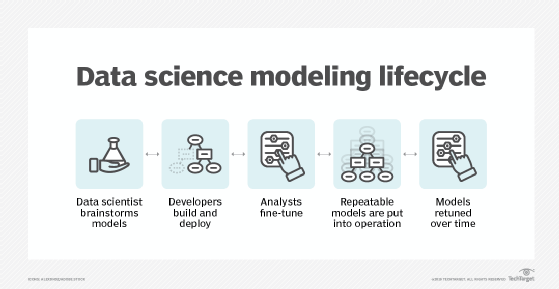
red150770 - Fotolia
Automated tools broaden the future scope of data science
Automated data science tools may make their way into the data science process, but are unlikely to ever be able to do everything human data scientists do, experts say.
Data science tools now automate various pieces of the analytics process, from data preparation to model selection. And automation will only broaden the future scope of data science.
According to most analytics and artificial intelligence experts, trends like augmented analytics will only increase the efficiency and reach of data science within the enterprise. Even with accelerating analytics automation, data scientists will be sitting pretty with job security for a long time.
"I think what is happening with AI and a lot of these technologies is they are making our jobs easier," said data science expert Usama Fayyad, co-founder of the Initiative for Analytics and Data Science Standards. "I actually do not believe at all that they're capable of replacing our jobs."
The analysts at Gartner predicted that within five years AI will automate 50% of the activities that data scientists engage in. That may be more of a reflection of the amount of manual labor that goes into data management and analysis than anything else.
Advancements in automation in data science and analytics target mundane, robotic, repetitive tasks -- things that "machines are better off doing than humans," Fayyad said. For example, Gartner predicted that the field of data management will see manual tasks reduced by 45% in the next three years through augmented data management that uses machine learning and AI to more efficiently categorize, prep, integrate and manage data sets.
The more that automation abstracts away manual data science processes, the more strategic the future scope of data science will be. Streamlining analytics work gives time and energy back to data scientists to focus on what has always been their core mission -- helping business leaders transform growing troves of data into actionable insights. According to a recent survey, 72% of organizations believe that their inability to glean insights from data analytics could negatively affect their bottom line.

"When you talk about the role of a data scientist, the most important things are critically thinking about the problem on the front end, developing the question to be answered by the data and then, on the back end, presenting the results -- telling a story and being able to properly articulate a diagnosis that's clear, relevant, accurate and precise," said Jon Christiansen, chief intelligence officer at Sparks Research and a professor of analytics at Charleston Southern University. Christiansen said that everything else in the data science future is just a matter of digging into different technological "cookbooks" to determine which way to slice and dice the data automatically, depending on the situation.
The core activity of cooking up insights doesn't change with more automation. However, the technological recipes that data scientists use to accomplish their goals do. Those three responsibilities -- identifying data-oriented problems, asking the right questions that analytics must solve and then interpreting the output into actionable guidance -- are at the heart of the role and the data science future, especially in the era of augmented analytics. Those are intensely human activities that simply cannot be automated.
"We need the humans because, to this date, we don't know how to build a machine that has common sense and [the] ability to come up with judgments under new situations quickly," Fayyad said.
That's likely why the prospects for the future scope of data science continue to look good for workers. The World Economic Forum noted that data science roles are some of the highest in-demand roles in the global labor market. And the U.S. Bureau of Labor Statistics predicted that data science roles are expected to grow by nearly 34% through 2026.






